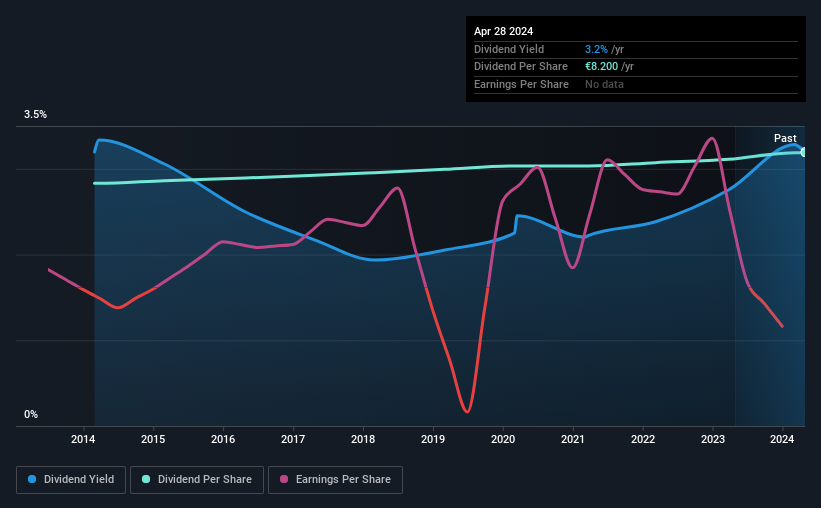Stock Analysis
- Belgium
- /
- Diversified Financial
- /
- ENXTBR:COMB
Read This Before Considering Compagnie du Bois Sauvage S.A. (EBR:COMB) For Its Upcoming €5.74 Dividend

Compagnie du Bois Sauvage S.A. (EBR:COMB) is about to trade ex-dividend in the next 3 days. The ex-dividend date is usually set to be one business day before the record date which is the cut-off date on which you must be present on the company's books as a shareholder in order to receive the dividend. The ex-dividend date is an important date to be aware of as any purchase of the stock made on or after this date might mean a late settlement that doesn't show on the record date. Thus, you can purchase Compagnie du Bois Sauvage's shares before the 2nd of May in order to receive the dividend, which the company will pay on the 6th of May.
The company's next dividend payment will be €5.74 per share. Last year, in total, the company distributed €8.20 to shareholders. Calculating the last year's worth of payments shows that Compagnie du Bois Sauvage has a trailing yield of 3.2% on the current share price of €256.00. If you buy this business for its dividend, you should have an idea of whether Compagnie du Bois Sauvage's dividend is reliable and sustainable. That's why we should always check whether the dividend payments appear sustainable, and if the company is growing.
See our latest analysis for Compagnie du Bois Sauvage
Dividends are typically paid out of company income, so if a company pays out more than it earned, its dividend is usually at a higher risk of being cut. Compagnie du Bois Sauvage reported a loss after tax last year, which means it's paying a dividend despite being unprofitable. While this might be a one-off event, this is unlikely to be sustainable in the long term.
Click here to see how much of its profit Compagnie du Bois Sauvage paid out over the last 12 months.

Have Earnings And Dividends Been Growing?
Companies with consistently growing earnings per share generally make the best dividend stocks, as they usually find it easier to grow dividends per share. If earnings fall far enough, the company could be forced to cut its dividend. Compagnie du Bois Sauvage was unprofitable last year, but at least the general trend suggests its earnings have been improving over the past five years. Even so, an unprofitable company whose business does not quickly recover is usually not a good candidate for dividend investors.
Another key way to measure a company's dividend prospects is by measuring its historical rate of dividend growth. Since the start of our data, 10 years ago, Compagnie du Bois Sauvage has lifted its dividend by approximately 1.2% a year on average. It's good to see both earnings and the dividend have improved - although the former has been rising much quicker than the latter, possibly due to the company reinvesting more of its profits in growth.
Get our latest analysis on Compagnie du Bois Sauvage's balance sheet health here.
To Sum It Up
Is Compagnie du Bois Sauvage worth buying for its dividend? We're a bit uncomfortable with it paying a dividend while being loss-making. In sum this is a middling combination, and we find it hard to get excited about the company from a dividend perspective.
If you want to look further into Compagnie du Bois Sauvage, it's worth knowing the risks this business faces. Our analysis shows 1 warning sign for Compagnie du Bois Sauvage and you should be aware of this before buying any shares.
A common investing mistake is buying the first interesting stock you see. Here you can find a full list of high-yield dividend stocks.
Valuation is complex, but we're helping make it simple.
Find out whether Compagnie du Bois Sauvage is potentially over or undervalued by checking out our comprehensive analysis, which includes fair value estimates, risks and warnings, dividends, insider transactions and financial health.
View the Free AnalysisHave feedback on this article? Concerned about the content? Get in touch with us directly. Alternatively, email editorial-team (at) simplywallst.com.
This article by Simply Wall St is general in nature. We provide commentary based on historical data and analyst forecasts only using an unbiased methodology and our articles are not intended to be financial advice. It does not constitute a recommendation to buy or sell any stock, and does not take account of your objectives, or your financial situation. We aim to bring you long-term focused analysis driven by fundamental data. Note that our analysis may not factor in the latest price-sensitive company announcements or qualitative material. Simply Wall St has no position in any stocks mentioned.
About ENXTBR:COMB
Compagnie du Bois Sauvage
Compagnie du Bois Sauvage S.A., an investment holding company, invests in the industrial and real estate sectors in Belgium.
Flawless balance sheet, good value and pays a dividend.

